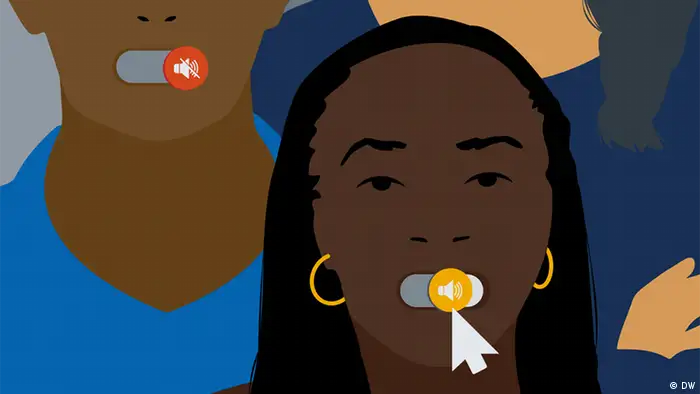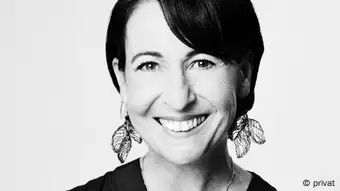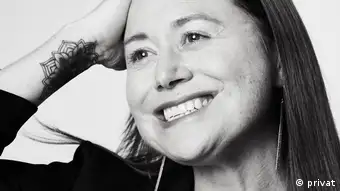media safety
The cost of silencing the voices
Women-identifying journalists, journalists of color and those from underrepresented communities are often the first and hardest hit in moments of crisis. By Elisa Lees Muñoz and Nadine Hoffman
The COVID-19 pandemic, disinformation campaigns, unbridled misogyny online, and attacks against the media from heads of state and others are just some of the threats to journalists and journalism as a whole worldwide. Women-identifying journalists, journalists of color and those from underrepresented communities, however, are often the first and hardest hit in moments of crisis, contributing to the lack of diversity of voices we hear. Moreover, it is driving mistrust among communities who do not see their reality reflected in the news—and in the end will no longer consume it.
With the rise of the coronavirus pandemic, authoritarian governments around the world have seized the opportunity to crack down on the press by criminalizing free speech, restricting access to information, and spreading disinformation. Journalists reporting unfavorably on the number of COVID-19 deaths in their countries have been singled out for abuse, with women journalists in particular being subjected to sexualized threats from troll armies. They have been hard hit by the pandemic, particularly freelancers who saw their assignments dry up overnight and whose movements were restricted when they were unable to show employment credentials. The rise on attacks on press freedom takes many forms and has an indelible impact on the viability of the news industry.
Worldwide trends documented by the International Women’s Media Foundation (IWMF) through ongoing work with thousands of women in our network point to specific ways journalists are being targeted, many of which are driving women out of the industry, thereby making the news media less representative, less equal, and less viable.
Four of the most prominent safety threats we have documented in the crisis impacting journalists, and women and underrepresented groups in particular, include:
– online harassment;
– misogyny in the field and in the workplace;
– pandemic fallout on press freedom;
– physical threats and attacks.
Journalists who remain in the industry, both male and female, have described changing approaches towards stories, and even avoiding reporting on certain topics that may result in a severe online backlash. Journalists find themselves passing on such stories or self-censoring the way they report to avoid the onslaught.
Based on IWMF data, gender equity goals and initiatives fall by the wayside as global leaders, policymakers and heads of industry tackle what they perceive to be more critical matters. They lose sight of the opportunity to fix cross-cutting, intersectional problems that permeate our societies and create long-term challenges.
This has a particular impact as women are more likely than their male peers to be primary caretakers for children or elderly parents. In a pandemic—where reporting a story could expose loved ones to infection—some women are making the painful decision that the assignment isn’t worth the risk. That calculation comes with a massive loss: urgently needed income. Financial hardship, exacerbated by caretaking responsibilities, is forcing many women, especially freelancers, out of the news industry. Many face homelessness and food insecurity.
Regional trends become global in times of crisis
Worldwide, news organizations are laying off staff and local newsrooms are facing dire revenue challenges. These layoffs and closings of independent media outlets are a boon for many governments, who are also using COVID-19 to escalate attacks against press freedom, newsrooms, and journalists.
In Bangladesh, as in many other countries, the Prime Minister’s attempts to conceal information about the pandemic led to attacks against journalists in the field. In the Philippines, Indonesia, Malaysia and Cambodia, journalists are facing charges and prison time for their critical reporting on COVID-19.
Mexico was already one of the most dangerous countries in the world for journalists before COVID-19. Now, journalists there face increased risks. In addition to attacks from organized criminal groups, hostility from government officials, and a nearly 100% rate of impunity, these journalists also have to deal with dire financial conditions in the current crisis. Because of COVID-19, media outlets are restructuring their business models by reducing and delaying payments to journalists indefinitely. Like others, the Mexican government has downplayed the risk of COVID-19 which has led to attacks on local journalists who report on the government’s response to the pandemic.
Online as well as offline, states are taking direct aim at journalists, with authoritarianism on the rise around the world. The Committee to Protect Journalists’ 2020 Global Impunity Index points to “corruption, weak institutions, and lack of political will to pursue robust investigations” as a main factor in cases of impunity for attacks on journalists. The number of journalists murdered fell in 2019, and CPJ cites the use of other tools beyond physical attacks to intimidate reporters as having the same desired outcome as physical violence for repressive regimes—it leads to self-censorship, and the silencing of journalists whose stories they don’t want told.
Online harassment and its real-world impact
Newsrooms have recognized the importance of protecting their reporters’ safety in the field; however, the same sense of urgency is needed to address online attacks, which are equally effective in silencing journalists’ voices, and which can lead to real-world danger. For example, a favorite tactic of white supremacist groups in the United States as well as in a number of Arabic countries is to dox journalists who report on their activities, publishing personal information like addresses and phone numbers, making them vulnerable to physical attacks.
Overall, online attacks are increasing. Perpetrators use various tactics across the board to attack journalists, but this tactic is most pronounced for women journalists and those from underrepresented communities who face online harassment and attacks every day, creating a hostile work environment, causing trauma, and impeding their vital work.
While online abuse affects journalists of all genders, women are especially targeted with misogynistic content and threats of sexual violence. This trend is global, and perpetrators include governments and their bot armies, Internet subcultures, racists, and people with political agendas. Some trolls belong to organized online groups that launch coordinated and sustained attacks, united in their hatred of women journalists participating in the digital public discourse. Women who report on feminist movements, women’s health and reproductive rights, and other gender issues often find themselves under attack. Other tactics used to intimidate and silence women-identifying journalists and those from underrepresented communities are difficult to quantify and often overlooked as tactics used to infringe on press freedom.
According to the IWMF’s 2018 research report with TrollBusters, Attacks and Harassment: The Impact on Female Journalists and Their Work, 70 percent of women working in news media have experienced digital threats or abuse, and a third of them have considered leaving the profession as a result. A 2017 report by the Association of Media Women in Kenya (AMWIK) and ARTICLE 19 detailed an increase in online attacks against female media workers, encompassing cyber stalking, sexual harassment, surveillance and unauthorized use and manipulation of personal information, including images and videos. Survey responses have also shown that a significant number were harassed as a result of the content of their reporting, and at the same time targeted for being women, or even attacked due to their gender and/or ethnic background. While these numbers are worrying, even more concerning is the fact that 43% of the victims did not take any action, and less than 10% reported the attacks to their employers. A journalist from Cameroon described what happened when she reported threats: “I was ostracised by other colleagues. No one wanted to be seen with me. I was removed from my office and asked to stop all work but continue reporting to the office. My salary was slashed.”
Other women have spoken out publicly against their online attackers. Patrícia Campos Mello, a Brazilian journalist covering disinformation and politics for Folha de São Paulo, exposed that business leaders had paid to disseminate millions of fake WhatsApp messages to influence the presidential election in 2018. She wrote about her experience with Brazilian President Jair Bolsonaro’s “office of hate” in a recent New York Times op ed. “I have faced a violent onslaught of crude threats and personal attacks. Trolls and even politicians have shared memes where my face appears in pornographic montages in which I am referred to as a prostitute. People send me messages that say I should be raped… I am not alone. Many respected female journalists in Brazil have also been the target of misogynistic attacks.”
The vicious attacks on journalists like Campos Mello are being replicated by governments hostile to press freedom around the world, from El Salvador to India to the Philippines, and under the administration of Donald Trump also in the United States. International advocacy campaigns on behalf of high-profile journalists like Maria Ressa of Rappler have put a spotlight on this egregious tactic; however, heads of state on all continents have taken license to use the press as a political tool, and it is unlikely that this will abate.
The many layers of threats journalists face, in particular women-identifying reporters and those from underrepresented communities (…) are driving them out of the news media. Without their voices and equal participation, we cannot have a free and representative press. Online as well as offline, states are taking direct aim at journalists, with authoritarianism on the rise around the world. 28 The many layers of threats journalists face, in particular women-identifying reporters and those from underrepresented communities, have a tangible chilling effect and come at a huge cost for us all. These threats are driving them out of the news media. The compounding impact of a monolithic news media landscape contributes to lack of trust and, eventually, diminished profits for news media outlets. More importantly, without their voices and equal participation, we cannot have a free and representative press. Without a free and representative press, our societies are not truly democratic. The news industry and the press freedom community have the responsibility to do more to ensure their safety, online and offline.
Elisa Lees Muñoz is the IWMF’s Executive Director. Elisa leads the organization to achieve its mission to support women journalists to develop their careers by providing training, tools and assistance so that they can work as safely as possible. She is charged with growing the IWMF by expanding its programs into new geographies; introducing new initiatives such as Hostile Environments and First Aid Training (HEFAT); partnering with other organizations; and driving communications and outreach to our core constituents. Elisa has been a human rights activist since graduating from the University of Maryland with an MA degree in International Relations. Before joining the IWMF as Director of Programs, Elisa lead the Crimes of War Education Project.
Nadine Hoffman is the IWMF’s (International Women’s Media Foundation) Deputy Director, and she can often be found wrangling journalists in under-reported places. After starting her career as a reporter in Boston, Nadine transitioned to non-profit work, focused on international human rights and education. She has been a part of the IWMF team since 2010. She is passionate about developing programs to support the IWMF’s global community of female journalists, traveling to far-flung places, and smashing the patriarchy.
DW recommends
Downloads
- Date 26.05.2021
- Author Elisa Lees Muñoz
- Feedback: Send us your feedback.
- Print Print this page
- Permalink https://p.dw.com/p/3sb04
- Date 26.05.2021
- Author Elisa Lees Muñoz
- Send us your feedback.
- Print Print this page
- Permalink https://p.dw.com/p/3sb04



